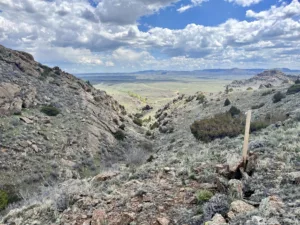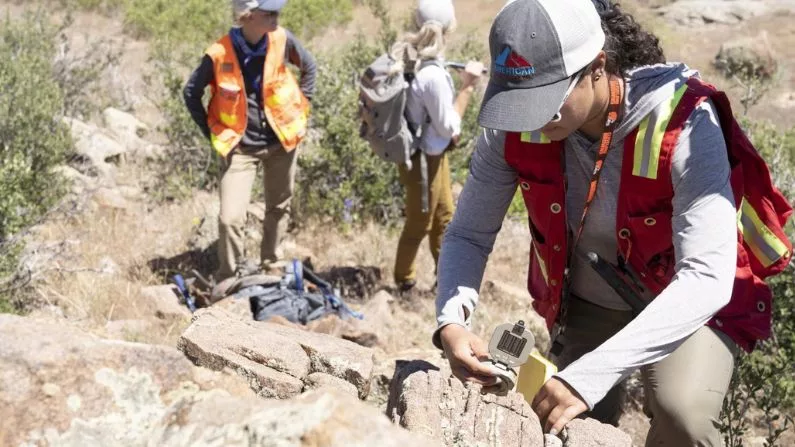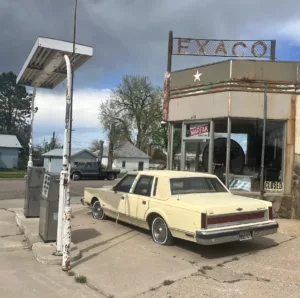This story comes through a content-sharing partnership with Wyoming Public Media.
Down a bumpy dirt road next to a small meandering creek in southeast Wyoming lies the site of a potentially massive rare earth mineral mine. These elements are used in many emerging technologies, including cell phones and solar panels, and they’re a growing part of the future of extractive industry in the Mountain West. But mining them here and in other places around the region is sure to have big impacts on nearby communities and the environment.
This site in the Laramie Mountains is remote. Just a couple of ranches are visible below, and the desolate hillsides contain cacti, animal droppings, shrubs and rocks. A few wooden stakes remain from previous surveys of the land.

A surveying stake at the Halleck Creek mining claims in Southeast Wyoming. (Will Walkey
/Wyoming Public Radio)
American Rare Earths owns about 8,000 acres of mining claims here – called the Halleck Creek Project – on a mix of private, federal and state land. The company announced promising results from exploratory drilling on Halleck Creek earlier this year, determining that there are about 5 million tons of rare earth oxides on their claims. This could make it the largest known deposit of these minerals in North America.
“We knew it was going to be big. We didn’t know it was going to be a monster, in the good sense of the word,” said Mel Sanderson, North American president of American Rare Earths. “We’ve drilled to 150 meters so far, and it is consistently a rich, heavily concentrated deposit to depth.”
Rare earths are a group of 17 little-known elements, like neodymium, praseodymium and scandium. Patty Webber with the Wyoming State Geological Survey said they’re in many products people use on a daily basis.
“Rare earths are used in a wide array of applications, including specialty glass products, steelmaking, batteries…various electronic components are critical for many defense technologies,” Webber said. “Their unique composition makes them very difficult to replace.”
The U.S. Geological Survey has designated most of them as critical for economic and national security. China currently dominates the rare earths market. With only one operating mine in the U.S., the Biden administration wants to expand the domestic supply of these minerals, as well as other “green” metals like cobalt and lithium.
“Any discovery at the moment, whether a new discovery or an update on a previously known deposit… is big news at the moment because it’s of high demand,” Webber said.
Rare earth elements are actually commonly found in the earth’s crust, just usually not at economical depths and concentrations. This discovery in Wyoming is unusual because the elements are consistently distributed, highly concentrated and not radioactive.
There could be more deposits like this in the Mountain West. American Rare Earths is also exploring a part of Arizona, and a Nevada company called U.S Critical Materials recently announced a major discovery in Montana’s Bitterroot Mountains. Geologists in Colorado and Idaho say those states are home to major rare earth deposits as well.
Developing a mine can take a long time due to permitting, environmental reviews and securing investment, among other hurdles. Sanderson said the Halleck Creek site won’t likely be able to begin operations for about five years, with mining fully ramping up to-scale in a few decades. But if the company is successful, it could eventually mean hundreds of jobs for the area.
“I like to flatter myself to think that rare earth can be for Wyoming what coal has been,” she said. “We’re going to need a whole garage system that keeps our fleet of vehicles running. We’re going to need a tire depot manager. We’re going to need pit bosses. We’re going to need all of those folks that have those high skills for the mining industry.”
The closest town to American Rare Earths’ claims is Wheatland, an agricultural center of about 3,500 where a Wendy’s will soon be setting up shop. Unlike other Wyoming towns, Wheatland hasn’t historically relied on drilling and mining. But according to Platte County Economic Development executive director Tracy de Ryk, the economy is slowing down. School enrollment has declined in recent years as the area has attracted more retirees.
So, de Ryk said the community could be open to a mining boom if it’s well managed.
“I think that to some extent they want to grow, but I think they want it to be a planned growth,” she said. “So I don’t think that they just want a huge influx of people to drive up housing prices and create infrastructure issues and overwhelm the services.”
There are many Western towns familiar with the tradeoffs that come with hardrock mining, and mining for rare earth elements and other critical minerals is no different. Halleck Creek would be an open pit mine, which has historically led to air and water contamination. There’s also enormous demand for the critical minerals lithium and cobalt, and mines in Nevada and Idaho are causing conflicts with tribal communities.
Advocates for Indigenous rights, including Kate Finn, executive director of First Peoples Worldwide, said that as demand for these critical minerals grows, more conflicts are inevitable in the West. One study estimated that 97 percent of nickel, 79 percent of lithium and 68 percent of cobalt reserves and resources are located within 35 miles of Native American reservations.
“As we step into the green economy, and this green energy transition, there is an opportunity for companies to do it right,” Finn said. “What does it look like when there’s tailing ponds? How are those tailings ponds managed? What does it look like if there were to be an environmental disaster? Who’s taking care of it? Those are big questions that tribal leaders haven’t been at the table for in the past.”
American Rare Earths has committed to studying the environmental impacts of a mine at their site and mitigating potential community harms.
This story was produced by the Mountain West News Bureau, a collaboration between Wyoming Public Media, Nevada Public Radio, Boise State Public Radio in Idaho, KUNR in Nevada, the O’Connor Center for the Rocky Mountain West in Montana, KUNC in Colorado, KUNM in New Mexico, with support from affiliate stations across the region. Funding for the Mountain West News Bureau is provided in part by the Corporation for Public Broadcasting.






